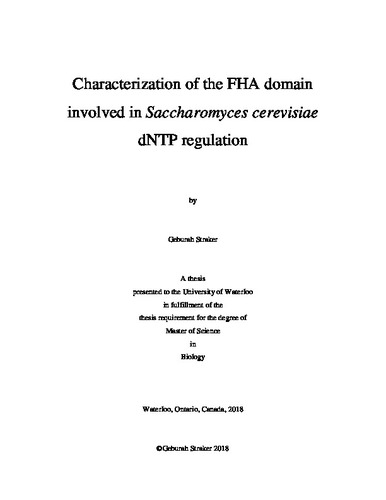| dc.description.abstract | Over 2000 Forkhead-associated (FHA) domain-containing proteins exhibiting diverse functions, such as kinases, phosphatases, and transcription factors, have been identified to date in both eukaryotic and prokaryotic organisms. Initially characterized as the only known protein-protein interaction motif with phosphothreonine (pThr)-binding specificity, research from the Duncker Lab that characterized the minimal interaction surfaces between the Rad53 FHA1 domain and the Dbf4 H-BRCT domain in the model organism Saccharomyces cerevisiae demonstrated the existence and importance of a conserved non-canonical binding surface on Rad53 FHA1 that does not rely on the phosphothreonine-binding patch. Recent analysis by the Duncker Lab of a Rad53 paralog called DNA damage UNinducible (Dun1), a budding yeast cell cycle checkpoint kinase involved in regulating dNTP synthesis, identified another instance of a conserved non-canonical FHA domain lateral surface interaction patch, located on the Dun1 FHA domain, similar to that of Rad53 FHA1. Continued examination of the Dun1 FHA domain lateral surface interaction patch and pThr-binding site suggested the existence of a differential requirement for the non-canonical FHA domain lateral surface interaction patch and the canonical pThr-binding site during interactions between Dun1 and some of its ligands.
The research presented in this thesis aimed to study the prevalence of protein-protein interactions in S. cerevisiae that operate using this novel non-canonical lateral surface interaction patch of FHA domains as well as their functional significance in cell growth and survival mechanisms in response to genotoxic stress, using the Dun1 FHA domain as an example. In order to investigate the existence and importance of Dun1 non-canonical FHA domain-based protein-protein interactions, bioinformatics analysis was used to identify candidate conserved residues on the FHA domain lateral surface interaction patch, site-directed mutagenesis was used to alter select amino acids and yeast two-hybrid assays were used to compare disruptions and/or the abrogation of protein-protein interactions between wild type and mutant Dun1 FHA domains with ligands involved in dNTP regulation. Analysis of the interaction between the FHA domain of Dun1 and proteins involved in the dNTP regulation pathway illustrated a differential requirement of the FHA domain lateral surface interaction patch and the pThr-binding site as well as a contribution of the kinase domain for the establishment of at least two interactions. Highly conserved residues of the Dun1 FHA domain lateral surface interaction patch contributed to FHA domain-based protein-protein interactions and slight but reproducible genotoxic sensitivity was observed for Dun1 FHA domain mutants. The interaction between Dun1 and Damage-regulated Import Facilitator (Dif1) suggested a contribution of the kinase activity of the Dun1 kinase domain to the establishment of a maximal interaction. In order to observe any interaction between Dun1 and Suppressor of mec1 lethality (Sml1), both the FHA and kinase domains needed to be present. Mutation of the conserved arginine 60 (R60A) residue of the canonical pThr-binding site completely disrupted the interaction between Dun1 and Dif1 whereas it only weakened the interaction between Dun1 and Sml1. Single mutations of the conserved asparagine 121 (N121A) and leucine 134 (L134A) of the non-canonical FHA domain lateral surface interaction patch did not affect the interaction between Dun1 and Dif1, but mutation of the conserved lysine 136 (K136A) within the context of just the Dun1 FHA domain increased the strength of the interaction between Dun1 and Dif1. The N121A single mutation had no affect on the interaction between Dun1 and Sml1 while both the L134A and K136A single mutations decreased the strength of the interaction between Dun1 and Sml1. The R60A, N121A, L134A, and K136A single mutants showed decreased growth in response to genotoxic stress, illustrating the importance of Dun1 interactions that utilize conserved residues of the non-canonical FHA domain lateral surface interaction patch and the canonical pThr-binding site to genotoxic stress responses in budding yeast. | en |

